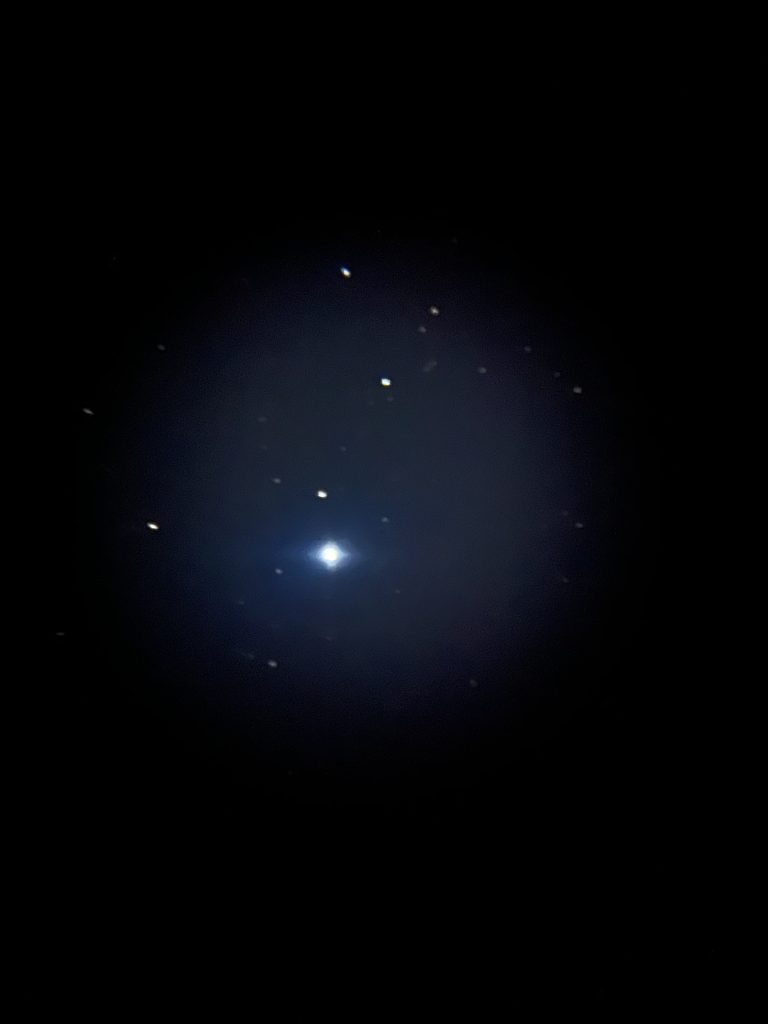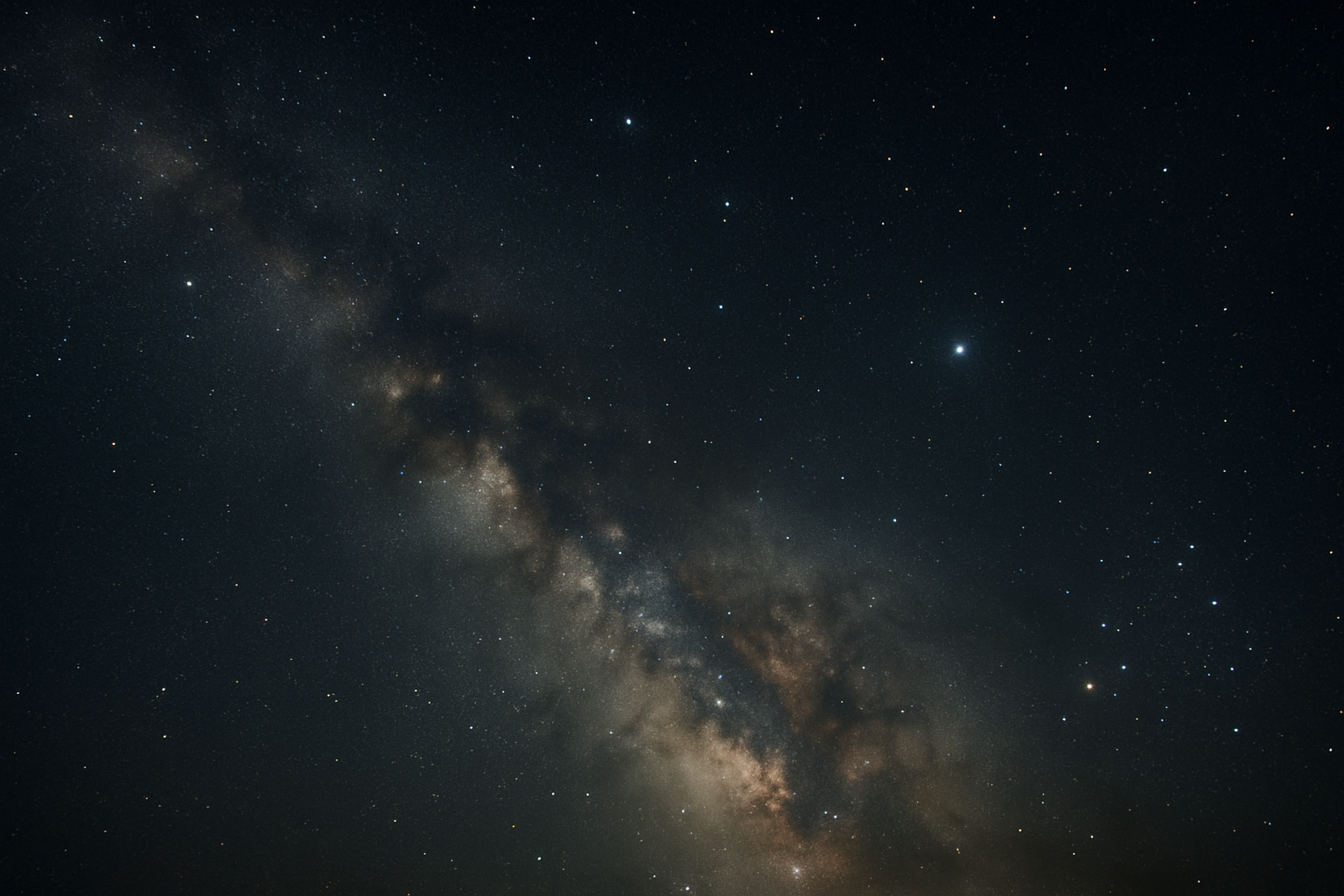My interest in astronomy, astrophysics, and cosmology is actually pretty fresh. On the last night of a one-week vacation this summer, I made the decision not to sleep (or I simply could not) and went up to the terrace of our vacation villa. I looked above… and just a moment of wow—I had never seen so many stars together, and never that bright. It was a clear night sky with very little to no light pollution.
As I was looking up, I realized that three of them were particularly grabbing my attention—the brightest ones in the summer night sky: Vega, Deneb, and Altair. Despite being hundreds of light-years from each other, they were collaborating in harmony and forming a triangle in the sky, which I then learned had an actual name: the Summer Triangle. They were all remarkable, but there was something that connected me strongly to Vega, some force much deeper than it just being the brightest in the sky. When I noticed that the photons I saw from her were emitted 25 years ago—making Vega 25 light-years away from our planet—I became even more interested in her.

It was a spectacular moment for me. I became immensely interested in stars and astronomy. Coincidentally, I was reading an astrophysics book at the time, just because I was curious. I quickly finished it and deepened my research in astronomy, stars, astrophysics, and cosmology. I read another astrophysics book, bought a telescope (though just for fun), watched videos, started another astronomy book, and found a documentary about cosmology and the science of the universe which I hope to finish soon. So, throughout my learning and research journey in astronomy and cosmology, I’ve learned many new things. As a total beginner, in this blog article I want to share my learnings about the science of the universe.
Not an optimal topic to start with but, since I was really into it, I want to introduce you to Vega. (Do not worry if you do not understand every term in this section, we will clarify them later.)
Vega is the 5th brightest star in our sky. It is the alpha star of the constellation Lyra and almost impossible to miss on clear summer nights.
She has a surface temperature of 10,000 Kelvin, about twice as hot as our Sun, making her a blue A0V-type main-sequence star. Interestingly, she has the mass of around two Suns as well.
Yet temperature or size aren’t directly related to the luminosity of stars. You might expect me to say it is far below our Sun’s. No. It is actually 40 times brighter than our Sun. Yes, 40 times. And being “only” 25 light-years (1 light-year is about ~9.5 TRILLION km, yes trillion with 12 zeros) away makes it one of the brightest stars for us to observe. However, everything has a payoff. Her giant mass and immense surface temperature cause her to have a lifespan of, again, “just” a few hundred million years, whereas our Sun’s expected life is about 10 billion years, and it is already halfway there with about 4.6 billion years of age.
Alright, let’s clarify some terminology and introduce some concepts, so that you also understand why I really fell for cosmology.
To start with, I have been using the terms “cosmology,” “astronomy,” and “astrophysics.” But what are these actually? Do I randomly spam whichever one comes to my mind? Nope.
Astronomy
Astronomy, by definition, is the scientific field that studies the celestial—sky bodies and phenomena.
Expressed more simply: the science of stars, planets, and the universe. In fact, the word astronomy in its roots means “the law/order of the stars” (astron: star + nomos: law/order).
Furthermore, astronomy is considered one of the oldest sciences, with ancient roots such as Babylonian and Greek.
And as I was researching the history of astronomy, I stumbled upon the fact that eastern scientists made immense impacts and discoveries during the Golden Age of Islam, just like their crucial contributions to other scientific fields. I became even more curious and dove deeper into research about the roots of Islam and its 600-year Golden Age in Baghdad.
But this will be discussed in another article—let’s get back to the universe.
Astrophysics
Astrophysics is a branch of astronomy that focuses on the physical properties of celestial objects.
So, it’s basically the physics of the stars and the universe. It refers to the how and why, whereas astronomy focuses more on the what.
Cosmology
Cosmology is the science of the cosmos. Having ancient Greek roots, the word cosmos (kósmos) means order, harmony, arrangement.
It refers to the universe viewed as a whole, encompassing everything from subatomic particles to the largest structures such as stars, black holes, and galactic clusters. In essence, it describes all matter and energy—the universe itself.
With this in mind, let’s learn about some cosmic concepts using Earth’s cosmic address:
Earth, Solar System, Orion Arm, Milky Way Galaxy, Local Group, Virgo Supercluster, Laniakea Supercluster, Observable Universe.
This is our postal address in the whole universe. If we ever find someone out there and somehow make them understand our language, we could describe our location with this.
Planets; Earth
To start with: we have planets. The one we live on is Earth.
Planets are defined as (1) celestial bodies that orbit the Sun (or another star, in the case of exoplanets), (2) with sufficient mass for their gravity to create a nearly round (elliptical) shape, and (3) that have eliminated any other bodies capable of moving in a neighboring orbit—meaning they do not allow other objects to share their orbit around the Sun. Planets that fulfill the first two but not the third criterion are considered dwarf planets, like Pluto. It shares its orbit with thousands of other icy and rocky objects (it’s in the Kuiper Belt).
Exoplanets or extrasolar planets are simply planets that are not in our solar system but orbit their own star. The discovery of thousands of these planets confirms that planets are a natural byproduct of star birth. How they are discovered is a whole topic for another article.
Planetary Systems; The Solar System
A planetary system is essentially a star and all the celestial bodies that orbit around it, held together by the star’s gravitational influence.
So, we have eight planets in our solar system. These are, from closest to farthest from the Sun: Mercury, Venus, Earth, Mars, Jupiter, Saturn, Uranus, and Neptune. Along with several dwarf planets including Pluto, over 180 moons, and billions of asteroids and comets, that is our solar system.
Our solar system is structured as: inner terrestrial planets, the Main Belt, outer gas giants, and the Kuiper Belt.
The inner terrestrial planets are the first four planets of our solar system: Mercury, Venus, Earth, and Mars. They have a rocky-metallic structure (consisting of a metal core surrounded by a rocky mantle and crust).
Then there is the so-called Main Belt (Asteroid Belt), a ring composed of rocky and icy objects.
After that, we have the gas giants, which are Jupiter, Saturn, Uranus, and Neptune. Gas giants are primarily composed of hydrogen and helium without a solid surface, unlike terrestrial planets.
Last but not least: the Kuiper Belt. Another flat ring of rocky and icy objects like the Main Belt, but with a greater diameter.
Galaxies; The Milky Way
Find a spot without any light pollution on a clear night. You will see an infinite amount of stars—well, this is obviously an exaggeration, but it seems as if there were infinite. However, all these stars are just in our own galaxy, the Milky Way. And that’s not even all. The Milky Way Galaxy has an estimated 200 billion stars. Considering there are also around 200 to 400 billion galaxies in the observable universe, there should be trillions of stars—and if they all have a few planets like our solar system, then the idea of being alone in the whole universe is both scary and perhaps even hard to imagine.
But what is a galaxy? A galaxy is a system made up of billions of stars, star systems, gas, dust, and dark matter, often arranged in a rotating disk or other shapes (like elliptical or irregular). Many galaxies, including our own Milky Way, contain a supermassive black hole at their center, around which all the stars, including our Sun, slowly orbit. In the Milky Way, this black hole is called Sagittarius A* and lies about 26,000 light-years away from us. Our Sun, along with the entire solar system, is in a section called the Orion Arm of the Milky Way Galaxy, and travels around the center of the galaxy—much like planets orbit the Sun, but on an unimaginably larger scale and over hundreds of millions of years.
A galactic year or a Sun year (the orbit of the Sun around the center of the galaxy) equals around 230 million Earth years. This means even though our Sun is aged around 4.6 billion Earth years, on the galactic year scale it is just a young adult with 20 years of age.
Clusters; The Local Group
Several galaxies grouped together form a cluster.
Our cluster, named the Local Group, contains, of course, our own galaxy, the Milky Way, another huge galaxy called Andromeda, and a bunch of other dwarf galaxies. Clusters together form a larger structure: a supercluster.
Superclusters; Laniakea
Superclusters are cosmic networks formed by clusters.
Our home supercluster is called Laniakea. Until 2014, the Virgo Supercluster was considered our supercluster, but in 2014 it was discovered that Virgo was only a branch of a much larger structure, Laniakea.
Observable Universe
The Observable Universe includes all these superclusters and cosmic networks, along with stars, planets, gas, dark matter, and time.
Observable? Not because we are capable of observing it all, but rather because we have a limit called the cosmic horizon. It basically refers to the last photon we, in theory, could see. The light of anything beyond that cosmic horizon has not reached us in nearly 13.6 billion years—since the beginning of the universe.
All in all, the universe is spectacularly beautiful and mysterious. How much we know about it is very limited. My interest was truly shaped by the realization of how tiny and clueless we are. As we spend time on worldly themes, we tend to forget about the reality outside. The more we focus on ourselves, the more we unsee everything else. So sometimes, one should leave things aside, raise their head, and look up.
This was an introduction to cosmology and the universe. Of course, there are a bunch of other concepts that we haven’t covered in this article, like dark matter and energy, how stars are born and die, how they are classified, or other physical concepts. Many more will come in the next articles.




